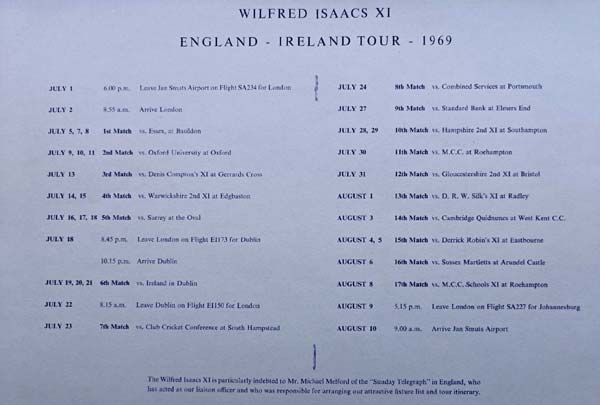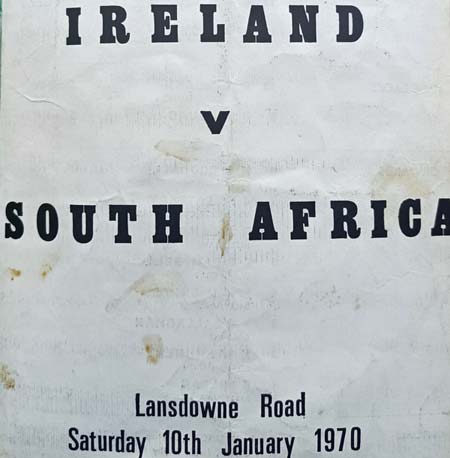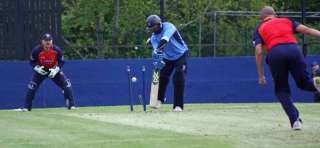The other game of 1969
A former Clontarf cricketer Margaret O’Brien once confided that “we were the lucky ones”. I was a bit bemused by this so she explained her thinking, that after 6 months of sport in one environment it was good to get away from a set of teammates and move onto a completely different group. Her winter sport took her to hockey in Trinity while I chased an oval ball in Donnybrook.
Many of our teammates while they moved into another sport continued to play with largely the same group of people. She had and still has a point. Even the spectators grow weary of each other at times. Still, it's always good to see a familiar face on the sidelines at Old Wesley rugby club where I will regularly see ex Phoenix men, Mike Halliday and Stan Mitchell. YMers Alan Lewis and the Bailey brothers Keith and Neil are also long time members of that same club.
The hockey scene retains a crossover between the sports but it is reducing these days, as seasons expand and pre season seems to take up most of the summer. The youngest plays hockey for Monkstown where former YM wicket keeper Lee Cole plays. Even if he wanted to play cricket, he will be otherwise occupied this summer as he prepares for an Olympic dream.
Early in the season, I thought that I noted a familiar face on the hockey sidelines, albeit one I hadn't seen for a number of years, but was it really him? I couldn't be sure. It was only when I discovered that the young player doing his stuff in the midfield for Monkstown was called Alex Murphy, could I be certain that indeed the familiar face was ex Phoenix, Dublin University, North Leinster and Ireland wicket keeper/batsman Gerry Murphy.
Gerry of course also coached the Irish rugby team, a decent CV, he has. It was good to say hello to Gerry, who has lost none of his wit in the intervening years.
Soon after our meeting, Gerry’s profile appeared on CricketEurope’s look back at international players. I took a look through it. One line stood out. And that was that in 1969 Gerry declined a debut cap.
1969 is famous in Irish cricket for the remarkable performance against the West Indies in Sion Mills. Two games against the West Indies took place in early July and the next game on the list was a 3 day game later in the month. The opposition at Rathmines was Wilfred Isaac’s XI. Who? Good question.
From the Wilfred Isaacs XI England -Ireland 1969 tour programme we can learn that “broadly speaking, the Isaacs XI consists of cricketers, young and old, who are invited to play in mid week matches against South African schools with the object of giving young cricketers experience against senior players”. The programme also reveals that the side, while primarily young, were virtually all provincial players in their homeland. There were some older more experienced players, one of which John Waite was a former Springbok wicket keeper, having retired in 1964.
The eponymous Wilfred Isaac, was a club player and Board Member of the Transvaal Cricket Board and he had captained the team carrying his name for 20 years.
The team were on a substantial tour, leaving South Africa on the 1 July and scheduled to return back on the 10 August. Seventeen matches were listed, a mix of 1,2 and 3 day games against invitational sides, County 2nd XI game as well, of course, as the interlude in Dublin.

The programme, which carries photos of the travelling party also indicates that the travelling party were all “white” South Africans. And therein lay the problem for Gerry Murphy.
Having spoken to Gerry, he sees the situation slightly differently to Ed Liddle in the CE profile. There had been just one change from the team that had played against the West Indies, with Phoenix’s David Ensor coming into the side. But backing up Ed Liddle’s assertion that a cap was there for Murphy, Derek Scott’s report on the game suggests that he had “refused to play against an all white South African team and thus missed what would have been a first cap” Both, of course, can be right in their interpretation. Convention was that a player’s availability was checked before selection so if Derek Scott was asking Gerry about his availability the chances were that he had either already been picked or was virtually certain to be so.
When I asked Gerry why he had made himself unavailable, there was no hesitation in stating that he was never going to play in the game because as Derek Scott correctly stated, he would not play against an all white side. South Africa had been expelled from FIFA as far back as 1961 and also from the 1964 Tokyo Olympics. However, they were still a part of the rugby fraternity and had played in Ireland in April 1965, attracting some protests.
While a student at Dublin University, Gerry had come across people who had an influence on his thinking. A couple of Bourke brothers were rugby teammates and he spent a lot of time with their family. The brothers had a sister Mary who is better known, now, by her married name, Robinson. Mary Robinson was a leading politician at national and local level before being elected the first female President in 1990.
Subsequently she became the UN High Commissioner for Human Rights and a founding member of The Elders, a group of world leaders advising on world problems. Throughout her career she has been an advocate for those in need. If Mary Robonson was an impressive individual, the other influence on Murphy was another to fit that billing.
Kadar Asmal, was a lecturer in Dublin University when the young Murphy was a student. Born in South Africa in 1934, he initially qualified as a teacher in his native country before moving to England and entering the academic world.
While in England he set up the Anti-Apartheid Movement and after moving to Dublin to lecture at Dublin University he together with his wife Louise started the Irish Ant-Apartheid Movement. Asmal’s leadership and ability to garner influence through alliance’s with trade unions and politicians meant that the IAAM set a model for the wider world to organise protests through the 60s.
Sport became a focus for many of these protests. The South Africa rugby team had come to Ireland in April 1965, while there were protests they were of a relatively mild nature, indeed Seamus Kelly on the front page of the Irish Times reported that the “banner bearing characters who caused a lot of embarrassment to old Liberals like me by heckling good-humouredly” Sport was used by the ruling National Party in South Africa to maintain a system of Apartheid, sport remained segregated, sport was racially divided and only whites could represent South Africa. Murphy’s decision to not make himself available for selection becomes understandable in this context.
While some sporting contact had been removed, rugby and cricket continued to welcome international teams and the Irish Cricket Union were content to extend the invitation to Wilfred Isaac’s XI in 1969.
If they read their newspapers on the early days of the tour in England they may have had some cause for concern. The tour’s first game in Basildon had been met by a protest and in the next game, the pitch at Oxford was damaged.
If that wasnt a good enough warning, the Irish Times ran an article on 11 July, 8 days before the game in Rathmines which included a statement from the IAAM which confirmed that a “picket and poster parade would be at the game”.

The statement also criticised “our sports administrators” for “ignoring the historic decision of the General Assembly of the United Nations in November 1968 when all member states were asked to break all sporting links with South Africa and Rhodesia” Indeed, it is a statement that seems to raise more questions as to why these sporting connections were continued in the face of worldwide political disapproval.
The warnings were indeed prophetic. Despite additional security staff and Garda advice, trouble was brewing. The Evening Herald of the 19th July, reported that only 52 minutes of play were possible before lunch, due to demonstrations. Their headline ran, rather predictably “Its not cricket!”
The official ICU report confirms that the demonstrators sat on the pitch and threw smoke bombs but acknowledged that “the first lot, some 15 of them, paid to come in” Newspaper reports suggested that these protestors were not actually members of IAAM or at least did not identify as such, rather than as members of Sinn Fein and the Connolly Youth Movement. Later in the day, however, in the words of the ICU “a more left-wing group got in by climbing over a garden wall”. There were further minor demonstrations throughout the 3 days but no further play was lost.

A young man subsequently appeared in court arising from the demonstrations. The game? That resulted in a draw and the Wilfed Isaacs touring party crossed back to England where they continued to meet demonstrations. Less than six months later, the issue was back in the spotlight when the South African rugby team came to Lansdowne Road and this time met much greater opposition on the streets and off. The IRFU programme for the game is the most basic affair as they were unable to find a printer willing to produce their usual fare.

However, politics move slowly, sporting contacts remained, but by the time the IRFU toured South Africa in 1981 the public was becoming more aware. The tour went ahead despite political concerns but while public opinion was turning, resolution was still some time away.
We started out with Gerry Murphy and we will finish there too. I wondered when chatting with Gerry if he had considered that in declining a cap, he may be losing his opportunity to play for Ireland. With trademark modesty, he simply put it that he “had never expected a cap so he didn’t feel that he was losing anything”.
But happily he did get capped. Gerry played three games in 1980. Having declined to play against an all white South African team he was pitted twice against the mighty West Indies.
Those games took place in Castle Avenue and were the first One Day games recognised as full capped games by the ICU. The first game was impacted by rain and the second was memorable for an imperious innings of 163 by Fahoud Bacchus.
Gerry’s third cap was against Middlesex in the Gillette Cup. Middlesex were an exceptionally strong team and won comfortably. However, in a coincidence of some magnitude, the Irish side were undone by Vintcent Van der Bilj whose 5 for 12 made a difficult job impossible. Van der Bilj as a young man had actually played against Ireland previously, and his bowling produced similar results then. The game was in 1969 when representing the Wilfred Isaacs XI in Rathmines.
Note1: What began as an idea when I spotted an seemingly off the cuff remark in a player profile on CricketEurope turned into something a lot more complicated very quickly. As a result, a number of people have helped enormously in piecing all the parts together. Pat Bracken delved into the newspapers of the time for me as well as providing a copy of the tour programme.
As ever, Ger Siggins was a great help, this time in pointing me towards his book on Lansdowne Road which details the 1970 rugby game and provided background on the IAAM. Similarly Andrew Vincent’s BA dissertation “How the 1981 Irish Rugby Tour affected Irish opinion on the Apartheid regime in South Africa” was hugely helpful in understanding the development of the IAAM and the role of Kader Asmal.
The game took place in Leinster CC and a Facebook page Memories of Leinster Cricket Club was where I found some of the photos included. The photos were posted on that page by the late Paul Reynolds but it is unlikely that they were his images, so I hope the admins don't mind me using them.
And finally, Gerry Murphy who was quite happy to talk about his memories of what to him was a simple question of availability for a cricket match. It was of course so much more. One of the things I love about sport and in particular the history of sport is seeing how it fits within the society of the time. A simple matter of conscience for one player in this case leads to the big questions of the time and the public's views which surround them. I wonder how many of us would have had the same convictions to deny ourselves a debut in the situation?
Note 2: Kader Asmal returned to South Africa in 1990 where his career continued on an upward trajectory,serving in a number of ministries. He died in 2011.




